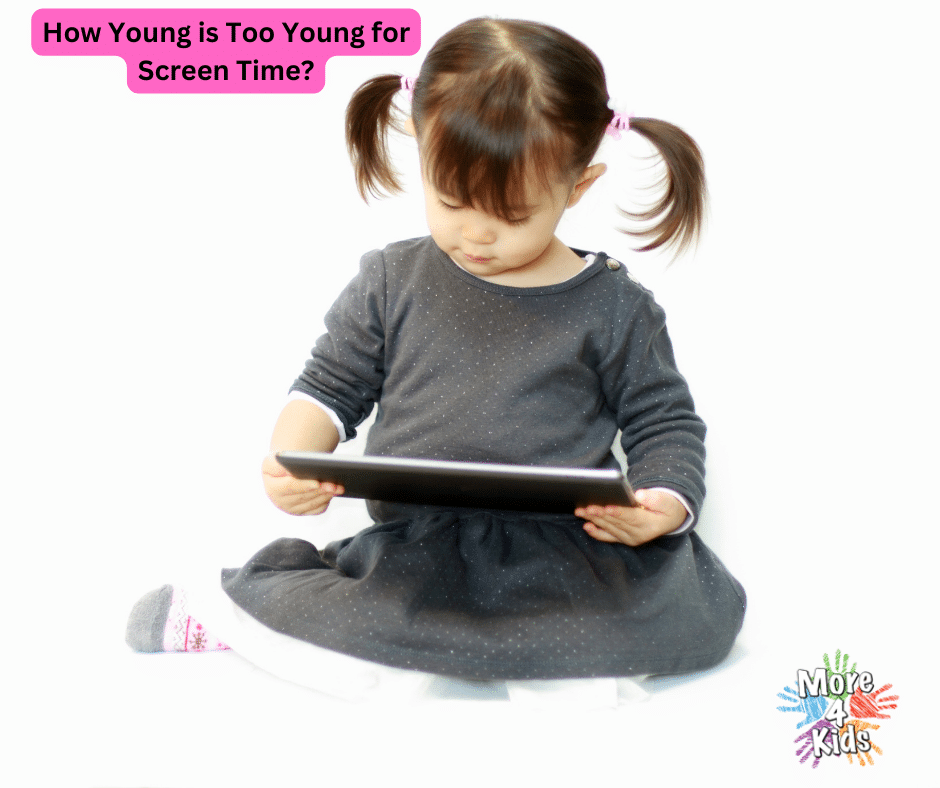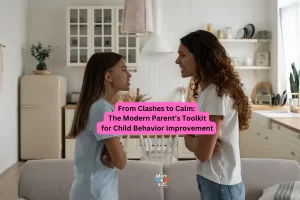Screen Time: How Young Is Too Young?
Table of Contents
The use of technology by people under the age of 18 has exploded, and especially screen time over the past decade. Our kids are digital natives that have access to phones, computers and tablets most of their day. According to the CDC, children ages 8-10 spend an average of 6 hours per day in front of a screen, with the average hours per day increasing as children get older. This is a new dilemma that generations of parents before us didn’t have to maneuver, so how are we to know what to do?
Two of the most common worries of parents are how much is too much screen time, and how young is too young for the screen? Unfortunately, there’s no right or wrong answer to these questions, but we can make informed decisions about how and when to monitor our children’s technology time. Previously, the Centers for Disease Control and American Academy of Pediatrics have both placed recommendations for hourly limits of daily screen time per age with children 0-2 having no screen time, children 2-5 having one hour or less, and children ages 5-17 getting two or less hours per day. Professionals have now moved from limiting how long your child has screen time to limiting and monitoring what your child is doing and watching on their screens. Let’s take a look at the benefits and drawbacks of screen time, and what screen time can mean in your child’s future.
Benefits of Screen Time
Communication with friends and family. Skype, Face Time and other video chatting apps allow children to connect with family members and friends from long distances when they otherwise may not be able to. Children who have separated parents can live with one parent while still being able to virtually see and talk to their other parent daily. Grandparents and other extended family that live far away can still have a meaningful relationship with the child, despite the distance. School aged children can interact with their peers through video chat and multiplayer online gaming.
While it’s not the preferred method of teaching and building communication skills, it does allow children to build relationships they wouldn’t otherwise be able to. The American Academy of Pediatrics considers video chat to be separate from a child’s daily screen time recommendations. While it doesn’t replace face-to-face interactions, screen time can help build both verbal and non-verbal language skills, as well as strengthen long distance friend and family relationships.
Encouraging learning. Educational screen time is defined as time children spend on technology viewing or participating in educational content, games, or programming. Almost two-thirds of kids play games on technology leisurely and this early familiarity with technology can make them incredible teaching tools. When screen time is monitored by a parent or guardian, kids can find plenty of educational games or shows that can help with areas like literacy, mathematics, and STEM.
Studies have shown that children under the age of 2 do not learn from screens like older children do. But for children who are older, teachers and parents can use screen time as a supplemental tool to encourage learning. Educational screen time can help enhance educational experiences. When educational screen time is multi-sensory (watching, listening, and using hand/finger to swipe or move objects on the screen), children are learning coordination and engaging more than one sense at a time.
Educational screen time can also help prepare your child for a future in the digital world. With devices being used in schools as well as in the work force, children who are digitally literate at a young age may have an advantage on others who have not had experience with devices. Educational screen time can also help children increase critical thinking and problem-solving skills through interactive games that require children to think about and work through a problem and then come up with a solution to complete tasks. While educational screen time has been found to be the most beneficial to children of all screen time types, it is important to remember that too much of any screen time can still lead to long term health effects.
Encourage creativity. Creative screen time can be beneficial for a child’s imagination and intellect. Creative screen time can include learning new skills on YouTube or other online learning and multimedia platforms, coding, making music, playing puzzle or problem-solving games that engage the brain, taking and editing digital photography and videos or creative writing. Screen time doesn’t have to be just sitting in front of a screen watching videos.
In the digital era we’re in now, kids can do amazing things like color a picture and watch it come to life, or experiment with music by playing different instruments on the screen. Kids can build entire worlds and populate them on popular multiplayer creative games. Monitor what types of screen time children are engaged in. Screen time can be used to introduce kids to experiences they may not have in the real world when properly monitored.
Drawbacks of Screen Time
Decreased language development. Studies have shown that for children ages 0-2, there are virtually no benefits for screen time because babies and young toddlers learn most from face-to-face human interactions. While young children will still hear and see people talking on a screen, they do not process it in the same way that they would with face-to-face interactions. One study found that children up to 24 months who spent more time on hand-held screens showed signs of expressive speech delays, which would include how children use sounds and words and how they put their words together to communicate. As children get older, they can handle more screen time and can gain more benefits from it. However parents should still monitor their usage and ensure they use it for educational purposes, rather than passively.
Passive screen time is defined as engaging in sedentary screen-based activities, such as watching videos or TV. When children are engaging in passive screen time, they are not engaging their brain as often as they would with more interactive forms of screen time like playing educational games or doing multisensory screen time experiences. While there are no studies that show that speech delays occur with too much screen time in older children, they are typically experiencing less interactions during passive screen time than they would if screen time was limited.
Decreased social skills. Obviously the more time a child spends looking at a screen, the less time they spend getting quality interactions with peers and adults. This can make it more difficult for children to establish interpersonal connections and build meaningful relationships with the people around them. These interactions and developed social skills are important for a child’s mental health and wellbeing. If you take a look around in this day and age, you are more likely to see a group of older children and teens looking at their phones, computers or tablets than you are to see a group of children playing interactive games together.
As said before, infants and young toddlers get virtually no benefits from screen time. When this age group spends more time in front of a screen, they are missing interactions with peers and adults around them that can help them develop social skills. As a preschool teacher, social skills are something that I’ve seen a huge decrease in over the past five years. Whether or not increased access to screen time is the cause of that is up for debate, but I would partially credit increased screen time for decreased social skills. Young children need to have meaningful interactions with their peers in order to learn how to share, identify other’s emotions and develop empathy towards others. If they are not engaging in these meaningful interactions face to face, they may have a harder time when they go to school.
Increase in challenging behaviors. Some studies have found statistically significant links between greater amounts of screen time and behavioral problems such as physical aggression, inattention, and defiance. When children are using screen time to engage in educational content and this time is limited and monitored, there may be no increase in challenging behaviors. If screen time is left un-monitored, children may watch content that is not appropriate for them, or engaging in games that are not suitable for their age. The bottom line for avoiding challenging behaviors while still allowing screen time is that we need to ensure that children are viewing age-appropriate content by monitoring what they are doing and seeing.
Decreased physical activity. The most common downfall to increased screen time for children is decreased physical activity. When children are spending time watching screens and playing video games, chances are they are not being physically active. The American Academy of Pediatrics reports that children who are physically active are going to have better cardiorespiratory fitness and stronger bones and muscles. Children who are sedentary are more likely to develop problems with obesity, high blood pressure, asthma, diabetes and joint problems. If parents and guardians are not setting limits on the amount of screen time a child is allowed to have per day, they are more likely to be sedentary and not engage in physical activity as often as they should. The CDC recommends children get at least one hour of physical activity each day. The easiest way to ensure that your child is getting enough physical activity is to limit their screen time to the recommended limit of less than an hour per day (ages 2-5) or two hours per day (ages 5-17), and encourage them to go outside or do some sort of physical exercise.
Future Implications
Overall, a parenting tip most professionals agree that children having too much screen time will negatively affect a child’s healthy development. While the CDC has previously placed limits on the amount of screen time a child gets per day, experts agree that rather than focus on an exact number, parents and guardians should be focusing on the quality of content that children are engaging in while on the screen. The Mayo Clinic has a great guild on screen time and children. It is clear that for children ages 0-2, screen time should only be used for communication with family and friends as there are virtually no benefits for this age range. This age is simply too young for technology. As children get older, they can gain more benefits from screen time which includes digital learning that may be needed as they grow in our technologically advanced society.
So, what can parents do to navigate this new frontier? First, don’t feel bad about giving your child some screen time. As said before, children over the age of two can benefit from screen time IF we are monitoring what they are viewing or playing AND we are limiting the screen time and balancing it with face-to-face interactions and physical activity. Parents can up with a family media use plan. The American Academy of Pediatrics has developed a “media use calculator” that can help you determine how much time your family is spending on daily living activities and what their daily screen time limit should be. It can sometimes be difficult to begin to figure out how to limit your child’s screen time, but it is worth the effort. When you make these small changes to develop screen time rules and routines with your child, you can help maximize the benefits and limit the negative effects.












Add Comment